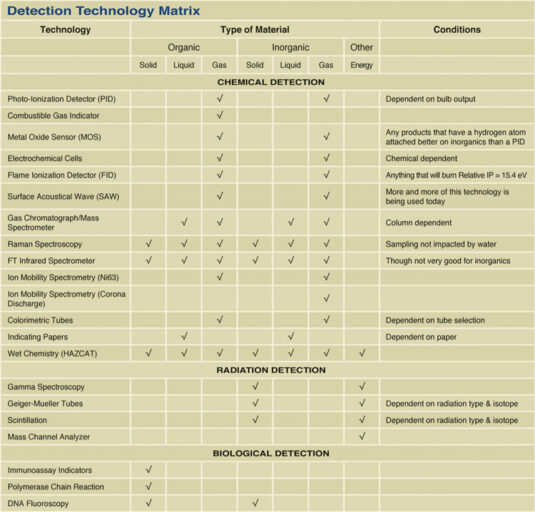Emergency-response teams across the nation have a continuing need for portable, reliable instruments that can be used to quickly and accurately characterize the hazardous materials known or likely to be encountered on the scene of a broad spectrum of incidents ranging from traffic accidents to chemical explosions to major fires. However, any investigation of a potentially contaminated site entails a parallel need for: (1) The detailed information required to know how to purchase the instruments and devices being used – and from what vendors; and (2) a comprehensive training program that prepares first responders not only how to cope with the risks they face at the accident scene but also how to make the rapid, but safe, decisions necessary to ensure personnel safety and mitigate the worst effects of the hazardous materials that might be encountered.
Today, fortunately, there are numerous manufacturers throughout the United States of detection equipment; those companies have pursued a broad range of options in their efforts to design, develop, and build products that are smaller, lighter, and easier to use than their predecessor systems – and that offer greater functionality as well. These manufacturers have almost literally reached far into the future to bring new technology into the present for use by today’s responders. One result is that there is now a very large number of vendors seeking to draw in emergency responders who want to purchase more sophisticated products for less money.
All of which brings up a relevant question – namely, has the technology ceiling, in the design and development of ever-improving detection systems, already been reached? There is also a relevant problem: by reaching so far into the future for new technology, today’s responders have not always gained, and/or retained, the ability needed to interpret the data being received in such unprecedented abundance.
To combat this problem, the nation’s emergency-response communities should perhaps adopt a longer-range “macro” approach in purchasing new detection instruments, tools, and systems. That approach should include the continued use of the multiple technologies available today – each of which gives the user complementary information that enhances the ability to understand the new systems coming into the market at any given time. In any case, no matter what materials are detected and monitored at the scene of an incident – particularly a potential mass-casualty incident (MCI) – certain basic criteria are necessary. To begin with, on-the-scene responders should know in advance, and as specifically as possible, what data they are looking for. That information will be used to determine the detection tools needed – different instruments, built to different standards, are used to detect and identify various chemical, biological, radiological, and/or explosive materials.
Today’s portable chemical detectors, to cite but one example, obviously should be of a robust design. This means that any new detection system should be able, from the start, to stand up to the very rough use likely in future field-test and/or on-the-scene operations. To meet this requirement the manufacturer should provide test data for the end user that describes the type of ruggedness testing the system has gone through – drop tests, for example, as well as exposure to both heat and cold, and to water. The bottom line: All future detectors should be waterproof, lightweight, have a long battery life, and be able to quickly and accurately detect a potentially hazardous material (and immediately sound an alarm). They also must be able to differentiate – i.e., to detect the materials they are intended to detect while remaining immune/indifferent to other materials that might contaminate or adversely affect the accuracy of the readings of the “intended” materials.
More for Less – Plus a Large Bonus
A long and continuing price competition between the various manufacturers of detection systems has brought the cost of those systems down considerably, and serves as a bonus factor that has benefited the response agencies and the communities they represent. Many of the monitors now being used, in fact, have dropped in cost by 60 percent or more – from an initial cost of perhaps $2,000 per unit several years ago to $600 or $700 today.Moreover, the reduction in cost has not been achieved by a reduction in capability but – partly because of increases in production – simply has made the same technology more affordable. Many of today’s meters, for example, are both lighter and smaller than their predecessors, and allow responders to use their instruments not only in more locations but also under more difficult working conditions. Giving additional impetus to this trend is that many of the latest units are using newer and more sophisticated circuit boards as well as smaller but more powerful batteries.
The nation’s emergency-responders are no longer using only the standard four-gas meters previously (and still) essential, but some new types of detectors as well – photo-ionization detectors (PIDs), for example. Which brings up another potential problem: Partly because of the onrush of technology, some highly capable systems perform well in detecting a large number of hazardous materials – volatile organic compounds (VOCs), for example – but do not always specify the essential differences between two or more materials detected at more or less the same time. The frequent result is a puzzling plethora of quantitative information lacking the qualitative characteristics also needed for full and final identification.
Obviously, the bar for new and even better response systems is now higher than ever before. Because of the increased concern about new terrorist attacks and the fear that chemical weapons of mass destruction (WMDs) may be used in those attacks a large number of advanced chemical detection devices have been developed by the private sector and are now on the market. Unfortunately, many responders have not been able to keep up with all of the new technologies that have been and are being introduced. They may know how to turn on a particular detection system, and/or how to take a sample with it, and even how to maintain it – but they do not always know exactly how it works.
Training Updates and the Canary Syndrome
Unfortunately, the problem does not end there – instead, it flows forward to the need for quickly and accurately interpreting the data provided by the meter and then making informed tactical decisions – in real time – on what to do next. The solution to most if not all of these inter-related problems is in the training available on the more sophisticated equipment now being used. That training, in many if not all cases, is or can be provided by the manufacturer. Today, most manufacturers of detection systems and other operational tools used on the scene by first responders do offer a relatively broad training program. However, many of those training programs are carried out by the manufacturer’s sales force rather than by professional trainers who possess hands-on experience in the use and interpretation of the detection/identification devices used by responders in the field.A related problem in this area is that many (but by no means all) manufacturers also fail to update the training on the high-tech systems they are selling – particularly the “advanced” models of the systems – and this omission gives the user a false sense of reach-back capability. The rule here is obvious: The user of any detection system not only needs to be able to understand and interpret the data provided any time that system detector is used but also needs refresher training when and if the system is upgraded and/or improved.
To summarize: Chemical detection has come a very long way from the “olden days” when coal miners used canaries as their principal (and only) detection system. The new detection tools being manufactured today are based on the best technology currently available. But many members of the response community may have reached the extent of the current training syllabus and lack the ability to use the improved new systems now in the research-and-production pipeline. However, with improved and frequently updated training this problem should be easily resolved. The key, of course, is in the training itself.
Training on the new detection systems being introduced should be a recurring requirement for first responders to become, and remain, proficient enough so that when an incident does occur they will be fully prepared to cope with it. All responder agencies should therefore develop and implement training policies that require each person who may be assigned the responsibility of using these high-tech detection tools in real-world operating situations to schedule his or her training on a regular basis. When this has become standard practice, a new and even higher ceiling of technology will be within easy reach.


Glen Rudner
Glen Rudner retired in 2022 as a manager of environmental operations for the Norfolk Southern (NS) Railway with environmental compliance and operations responsibilities in Tennessee, Alabama, Mississippi, and Louisiana. Previously, he was the hazardous materials compliance officer for NS’s Alabama Division (covering Alabama, Mississippi, Louisiana, and southwestern Tennessee). Prior to NS, he served as one of the general managers at the Security and Emergency Response Training Center in Pueblo, Colorado. He worked as a private consultant and retired as a hazardous materials response officer for the Virginia Department of Emergency Management. He has nearly 42 years of experience in public safety. He spent 12 years as a career firefighter/hazardous materials specialist for the City of Alexandria Fire Department, as well as a former volunteer firefighter, emergency medical technician, and officer. As a subcontractor, he served as a consultant and assisted in developing training programs for local, state, and federal agencies. He serves as secretary for the National Fire Protection Association Technical Committee on Hazardous Materials Response. He is a member of the International Association of Fire Chiefs Hazardous Materials Committee, a member of the American Society of Testing and Materials, and a former co-chairman of the Ethanol Emergency Response Coalition. He served as a member of the FEMA NAC RESPONSE Subcommittee.
-
Glen Rudnerhttps://domprep.com/author/glen-rudner
-
Glen Rudnerhttps://domprep.com/author/glen-rudner
-
Glen Rudnerhttps://domprep.com/author/glen-rudner
-
Glen Rudnerhttps://domprep.com/author/glen-rudner






